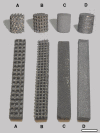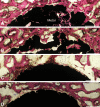Frictional and bone ingrowth properties of engineered surface topographies produced by electron beam technology
- PMID: 21161665
- PMCID: PMC3078515
- DOI: 10.1007/s00402-010-1218-9
Frictional and bone ingrowth properties of engineered surface topographies produced by electron beam technology
Abstract
Background: Electron beam melting (E-beam) is a new technology to produce 3-dimensional surface topographies for cementless orthopedic implants.
Methods: The friction coefficients of two newly developed E-beam produced surface topographies were in vitro compared with sandblasted E-beam and titanium plasma sprayed controls. Bone ingrowth (direct bone-implant contact) was determined by implanting the samples in the femoral condyles of 6 goats for a period of 6 weeks.
Results: Friction coefficients of the new structures were comparable to the titanium plasma sprayed control. The direct bone-implant contact was 23.9 and 24.5% for the new surface structures. Bone-implant contact of the sandblasted and titanium plasma sprayed control was 18.2 and 25.5%, respectively.
Conclusions: The frictional and bone ingrowth properties of the E-beam produced surface structures are similar to the plasma-sprayed control. However, since the maximal bone ingrowth had not been reached for the E-beam structures during the relatively short-term period, longer-term follow-up studies are needed to assess whether the E-beam structures lead to a better long-term performance than surfaces currently in use, such as titanium plasma spray coating.
Figures




References
-
- Mendenhall S. Hip and knee implant review. Orthop Netw News. 2004;15:1–16.
-
- Eskelinen A, Remes V, Helenius I, Pulkkinen P, Nevalainen J, Paavolainen P. Uncemented total hip arthroplasty for primary osteoarthritis in young patients: a mid-to long-term follow-up study from the Finnish Arthroplasty Register. Acta Orthop. 2006;77:57–70. doi: 10.1080/17453670610045704. - DOI - PubMed
-
- Karrholm J, Garellick G, Herberts P (2007) Annual report 2006. Swedish National Hip Arthroplasty Register
Publication types
MeSH terms
Substances
LinkOut - more resources
Full Text Sources
Other Literature Sources

